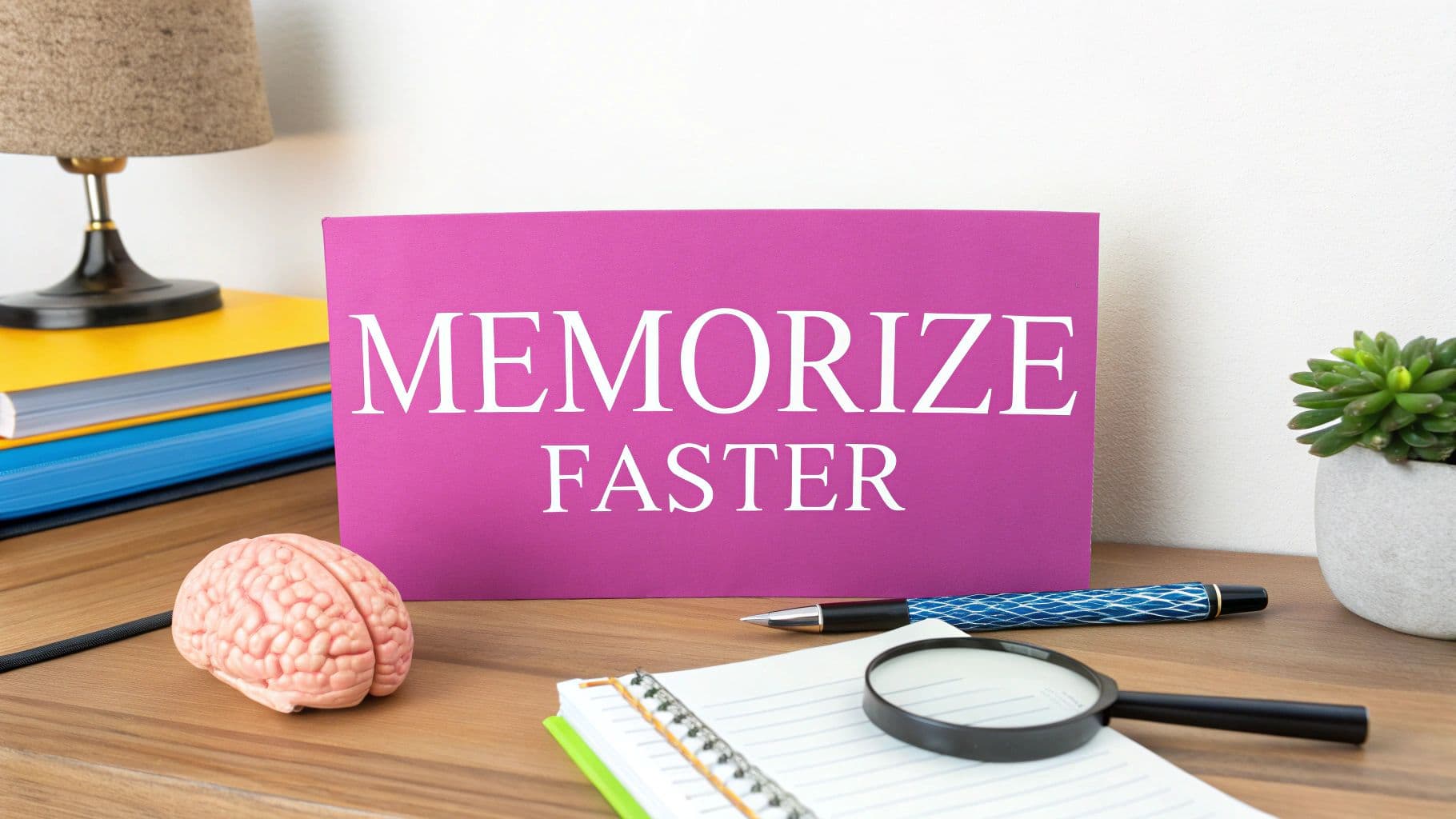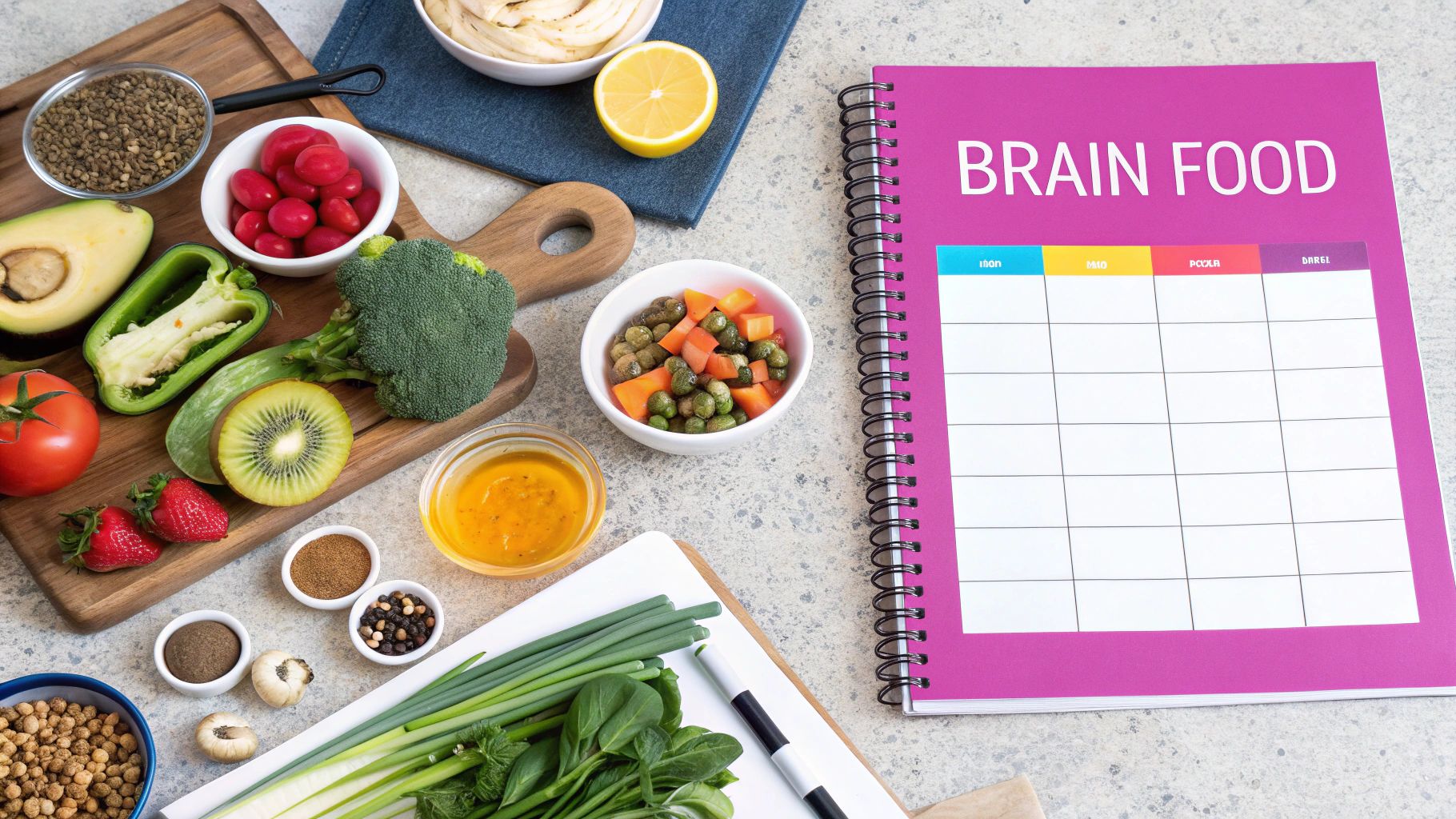
How to Memorize Faster: Science-Backed Methods That Actually Work
Understanding How Your Brain Really Learns

Your brain is an amazingly active organ that constantly rewires itself as you learn new things. Rather than just storing information like a computer hard drive, it actively builds and rebuilds connections between neurons. This means that simply reading or hearing something repeatedly isn't enough – you need to engage with information in specific ways to make it stick.
The Importance of Active Recall
Think about what happens when you try to memorize a new concept. Reading it over and over might make it feel familiar, but that feeling is often temporary. Active recall – testing yourself by trying to remember information without looking at notes – creates much stronger memories. Even when you struggle to remember something and get it wrong, that mental effort helps your brain recognize the information as important. The more you practice retrieving memories, the stronger and more accessible those neural pathways become.
The Role of Spaced Repetition
To move information into long-term memory, you need to review it multiple times using increasing intervals. Start by testing yourself after a few minutes, then hours, then days. This spaced repetition works with your brain's natural forgetting curve – the way memories fade over time. By reviewing material right before you're likely to forget it, you strengthen those memories and make them more permanent. This focused approach helps you spend time on what you're most likely to forget.
Chunking Information for Easier Processing
Your brain naturally looks for patterns to make sense of information. Chunking takes advantage of this by grouping small pieces of information into meaningful clusters. Just as you organize files into folders on a computer, chunking helps your brain process and store information more efficiently. For example, phone numbers are easier to remember when split into chunks (555-867-5309) rather than as one long string of digits.
Making Connections Through Elaboration
One of the most powerful ways to remember new information is to connect it to things you already know. This process, called elaboration, might involve creating mental images, making up stories, or linking concepts to your personal experiences. Like building a network of roads, each new connection gives your brain another path to reach that memory. The more connections you create, the easier it becomes to recall the information later. By using these techniques – active recall, spaced repetition, chunking, and elaboration – you can work with your brain's natural learning processes to remember information more quickly and effectively.
Building Your First Memory Palace
The memory palace technique, also known as the method of loci, is one of the most powerful ways to retain large amounts of information. While techniques like elaboration and spaced repetition are useful, memory champions particularly favor this spatial method that turns abstract information into vivid mental imagery. Though it may sound complex at first, the approach is quite straightforward in practice.
Choosing Your Palace
Start by selecting a place you know extremely well as your "palace" – this could be your home, workplace, a familiar walking route, or even a level from your favorite game. The key is picking a location you can mentally navigate with ease, seeing all the details clearly in your mind. Research supports the effectiveness of this spatial approach – a 2017 study by Martin Dresler and colleagues found that people using the method of loci remembered significantly more words compared to control groups.
Defining Your Route and Stations
After choosing your palace, map out a specific path through it rather than wandering randomly. If using your house, you might start at the front door, move through the living room, enter the kitchen, go upstairs, and so on. Along this route, identify clear "stations" or specific spots where you'll place memory images. These could be furniture pieces, artwork, doorways, or any distinctive features. For instance, in your living room, the couch could be station one, the TV station two, and the coffee table station three. The more unique and memorable each station, the better it will work.
Placing Images at Your Stations
Let's say you need to remember a grocery list: milk, eggs, bread, cheese, and apples. Rather than trying to memorize the plain list, create vivid, exaggerated mental pictures for each item and place them at your stations. Picture milk flooding your sofa, chickens laying eggs all over your TV screen, a giant bread loaf balanced on the coffee table, cheese melting down the kitchen counter, and an apple tree bursting through your sink. The more unusual and multi-sensory these mental images are, the easier they'll be to recall later. This approach uses elaboration by connecting new information to your existing knowledge of the space.
The Power of Repetition and Review
Like any memory method, the memory palace takes practice to master. Make it a habit to mentally walk through your palace and review the images at each station. Begin with frequent short reviews and gradually space them further apart over time. Studies have shown that Memory Enhancement Techniques (METs) consistently improve retention – one study of nursing students found their mean scores increased significantly from 50.75 to 58.76 (p < 0.0001) after implementing these techniques. With regular practice of the memory palace method, you can develop reliable systems for quickly learning and recalling new information.
Making Mnemonics That Actually Stick

Memory palaces are just one tool in the memorization toolkit. Mnemonics offer another powerful way to learn and retain information more effectively. These memory techniques turn abstract facts into vivid mental images and patterns that your brain can easily grasp and recall. Rather than struggling to memorize raw information, you can work with your brain's natural ability to remember stories, rhymes, and associations.
Types of Mnemonics and How to Use Them
Different types of mnemonics work well for different learning styles and kinds of information. Acronyms are a common approach – taking the first letter of each word to create a memorable term. For instance, ROYGBIV helps students remember the colors of the rainbow (Red, Orange, Yellow, Green, Blue, Indigo, Violet). This works especially well for remembering items in a specific order.
Acrostics expand on acronyms by creating meaningful sentences where each word's first letter represents something to remember. Music students often use "Every Good Boy Deserves Fudge" to recall the lines of the treble clef (EGBDF). The sentence adds context and meaning that makes the information stick better in memory.
Think about the nursery rhymes and songs you learned as a child – chances are you still remember them today. That's because rhymes and melodies engage multiple parts of your brain at once, creating stronger memory connections. The rhythm and rhyming patterns make information much more memorable than plain facts.
Visual imagery also forms a key part of effective mnemonics. By creating unusual mental pictures linked to what you want to remember, you build strong memory pathways. For example, to remember that "pomme" means apple in French, you might picture a bomb (which sounds similar) exploding in an apple tree. The more distinctive and memorable the image, the better it works.
Crafting Mnemonics for Maximum Impact
Making mnemonics that truly work takes more than just random word play or images. You need a thoughtful approach that fits your learning style and helps encode information effectively. The key is personalizing mnemonics by connecting them to things you already know and understand well.
Build on your existing knowledge by linking new information to familiar concepts – this strengthens the neural connections that help you remember. For even better results, engage multiple senses in your mnemonics. Combine visual elements with sounds and physical movements to create richer memory cues that are easier to recall later.
Keep in mind that different mnemonic techniques work better for different people and different types of information. Some people connect best with visual imagery, while others remember rhymes more easily. Try various approaches to find what clicks for you. The goal is discovering memory techniques that match how you learn best.
Practicing and Refining Your Mnemonics
Like any skill, using mnemonics effectively takes practice and repetition. Review your memory aids regularly, especially using spaced practice over time. This helps move information into long-term memory where you can easily access it. As you practice, adjust your mnemonics if needed to make them more effective. Don't hesitate to modify or replace memory aids that aren't working well. Over time, you'll develop your own set of reliable mnemonic tools that help you memorize new information quickly and thoroughly. This structured approach works far better than trying to cram facts without any memory strategies.
Mastering The Art Of Information Chunking
The human brain excels at recognizing patterns. This natural ability to identify and classify information forms the basis of chunking—an effective method for faster memorization. When you chunk information, you group small pieces into larger, meaningful units. It's similar to organizing computer files into folders rather than having hundreds scattered across your desktop. This organization helps your brain store and access information more efficiently.
Why Chunking Works
The power of chunking comes from how it reduces strain on your working memory. This part of your brain, which actively processes information, can only handle about seven items at once (plus or minus two). By combining individual pieces into larger chunks, you decrease the number of separate items your working memory needs to juggle. This frees up mental capacity for deeper understanding and quicker memorization.
Consider trying to remember the number 198720011776. Attempting to memorize twelve separate digits is difficult. However, when you break it into meaningful dates—1987, 2001, and 1776—it becomes much simpler. You've transformed twelve individual pieces into three meaningful groups.
Practical Chunking Techniques
Here are concrete ways to apply chunking in your daily learning:
- Identify Natural Groupings: Search for existing patterns and connections in your study material. These might include time-based sequences, topic relationships, or structural similarities.
- Create Meaningful Categories: When natural groups aren't obvious, make your own. For instance, group vocabulary by themes, historical events by time periods, or scientific concepts by their functions.
- Use Visual Aids: Create diagrams, mind maps, and flowcharts to show relationships between chunks visually. These visual tools help cement connections between different concepts.
- Practice Active Recall: Test yourself regularly on the grouped information. This strengthens the mental links between items in each chunk and makes retrieval easier later.
Chunking Beyond Numbers: Applying It to Any Subject
While chunking works well for numbers, you can apply it to almost any topic. When learning a new language, group words by themes like food, travel, or emotions. For history studies, organize events by era or key figures. Even complex academic topics become more approachable when broken into smaller, connected chunks. This method helps build strong knowledge foundations while making information easier to remember. By understanding and using these chunking techniques, you'll find yourself learning and remembering information more effectively.
Creating Your Perfect Practice Schedule

After mastering key memorization techniques like memory palaces, mnemonics, and chunking information, the next step is developing a study routine that helps you learn efficiently. The science of spaced repetition is key to retaining information over the long term. Let's explore how to create a practical review schedule that aligns with your schedule and learning goals.
Understanding the Spacing Effect
Research in cognitive psychology has consistently shown that spreading out study sessions leads to better learning compared to cramming everything at once. When you space out your reviews over time, even with the same total study duration, you remember more in the long run. For example, a study of nursing students found that using spaced repetition and other memory techniques significantly improved test scores compared to traditional study methods.
Building Your Spaced Repetition Schedule
While creating a spaced review schedule might sound complicated, the basic concept is straightforward – review material at gradually increasing time intervals.
- Initial Review: Take a few minutes to go over the material right after first learning it to help cement it in your short-term memory
- Second Review: Return to the material after a few hours to start moving it into long-term memory
- Subsequent Reviews: Review again at growing intervals – the next day, then a few days later, then weekly. Adjust the timing based on how well you remember things. If something is hard to recall, schedule the next review sooner.
Here's a sample schedule for learning new vocabulary:
| Review | Time After Initial Learning |
|---|---|
| 1 | 5 minutes |
| 2 | 2 hours |
| 3 | 1 day |
| 4 | 3 days |
| 5 | 1 week |
| 6 | 2 weeks |
| 7 | 1 month |
Integrating Active Recall and Testing
For spaced repetition to work best, combine it with active recall rather than passive review. Challenge yourself to retrieve information from memory instead of just re-reading notes. This strengthens the neural pathways that help you remember. Try using flashcards, practice questions, or explaining concepts without looking at materials. The effort required to recall actually helps build stronger memories.
Managing Time and Motivation
Creating a schedule is one thing – sticking to it is another challenge entirely. Be realistic about your daily study time. Consistent short sessions are more effective than occasional long cramming sessions. Break study time into focused chunks using a timer, and reward yourself after completing sessions. Mix up your practice by using different memory techniques – perhaps building a memory palace one day and creating mnemonics the next. This variety helps reinforce learning while keeping your study sessions engaging and productive.
Putting It All Together: Your Rapid Learning Blueprint

Now that you understand the key techniques for faster memorization – memory palaces, mnemonics, chunking, and spaced repetition – it's time to combine them into a system that works for you. Like ingredients in a recipe, these methods blend together to create something greater than the sum of their parts. Let's explore how to build your own effective learning strategy.
Designing Your Personalized Learning System
Everyone learns differently, so the key is finding the right mix of techniques that match your style and needs. If you're a visual person, memory palaces might be your foundation. If you enjoy wordplay, mnemonics could be your go-to tool. The best approach is to start simple – try each method individually to understand what clicks for you. Then begin combining them in ways that make sense, like using a memory palace to organize chunked information or creating memorable phrases to connect key concepts.
Choosing the Right Techniques for Different Scenarios
Different learning situations call for specific approaches. When studying vocabulary, mnemonics paired with spaced repetition often work best. For mastering a presentation, a memory palace might be more effective. Medical students, for example, often use memory palaces to learn anatomy by linking body structures to specific locations in their mental maps. This helps them quickly recall complex information when they need it most. The key is matching the method to your immediate learning goals.
Troubleshooting Common Challenges
Learning new memory techniques takes practice, and you'll likely face some hurdles along the way. Here are practical solutions to common challenges:
- Difficulty Visualizing: Start with simple, familiar objects and gradually build up to more complex scenes. Regular practice will strengthen your visualization skills.
- Forgetting Mnemonics: Make your memory aids personally meaningful and even silly – the more memorable, the better they'll stick.
- Struggling with Spaced Repetition: Use a flashcard app to keep track of review schedules and stay consistent with practice.
Tracking Your Progress and Making Adjustments
Monitor how well your learning system works by keeping track of your speed and retention. Are you picking up new information more quickly? Can you recall it weeks or months later? If something isn't working, adjust your approach. You might need to space your review sessions differently or try new combinations of techniques. Stay flexible and willing to adapt your methods based on results.
This structured approach to learning helps you build a reliable system for acquiring and retaining information effectively. By understanding and applying these methods thoughtfully, you'll develop learning habits that serve you well in any educational pursuit.
Ready to boost your learning potential? Notescast is an app that turns your study materials into engaging video content, making learning 93% easier than traditional reading while improving retention and focus by over 90%. Visit https://notescast.app/ today to see how it can help you memorize faster and reach your academic goals.
